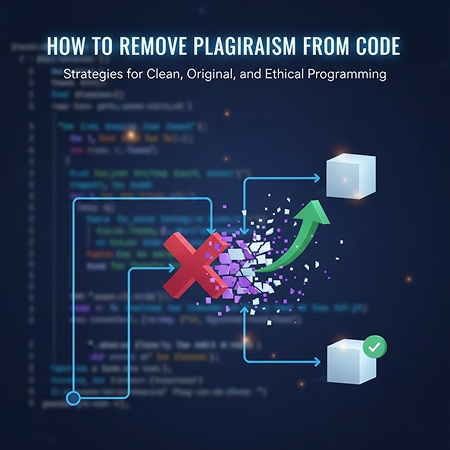How to Remove Plagiarism from Code Easily: A Complete Guide
Code plagiarism is a growing concern for students, developers, and professionals. The rise of AI coding tools like ChatGPT has made this even more complicated. Students and developers now face new questions about what counts as original work.
This guide will walk you through everything you need to know. You'll learn how to remove plagiarism from code online for free and ways to handle AI generated code properly. Let's start by understanding what we're dealing with.
Catalogs:
What Is Plagiarism Code?

Plagiarism code means using someone else's code and claiming it as your own work. This happens more often than you might think.
Common Types of Code Plagiarism
-
Direct copying. Taking code from GitHub, Stack Overflow, classmates, or tutorials without any changes. This is the most obvious form.
-
Superficial modifications. Changing variable names from "count" to "counter" or swapping a few lines around. The logic and structure remain identical.
-
Uncredited borrowing. Using code from open source projects or online resources without mentioning the source. Even if you modified it, failing to credit is plagiarism.
-
AI code misuse. Taking code from ChatGPT or similar tools and submitting it as your own work without understanding or modification.
Consequences of Plagiarism in Coding Tests
-
Academic Consequences: Plagiarizing code in school can result in failing the assignment or course, damaging your academic record, and blocking future opportunities like scholarships or graduate studies. It also harms your reputation among professors and peers.
-
Professional Consequences: In a job setting, code plagiarism can lead to being fired, facing legal trouble for copyright violations, and losing credibility in the tech community, making it difficult to get hired again.
How to Remove Plagiarism from Code Online Free?
You don't need expensive tools to make your code original. Here are practical free methods anyone can use.
Understand the Code Completely
Before rewriting, take time to understand what the code does. Break it down into its purpose, inputs, outputs, and logic. For example, if you have a Python function that reverses a string, figure out how it handles the input and what steps it takes. Use tools like debuggers or draw a flowchart to visualize the process. This step ensures you're not just copying but truly grasping the solution, which is critical for creating your own version.
Rewrite from Scratch
Once you understand the code, close the original source and write it in your own way. Change variable names to something meaningful but different. For example, instead of count, use totalItems. Swap control structures, like using a while loop instead of a for loop. You can also try a different algorithm if it achieves the same result, like using quicksort instead of bubble sort for sorting.
Change the Coding Style
Make your code look unique by adjusting its style. Use different indentation (like two spaces instead of four) or add your own comments to explain the logic. You can also switch programming approaches, like moving from procedural to object-oriented code. After rewriting, run your code through a formatter like Black for Python or Prettier for JavaScript to enforce your style. These changes help reduce similarity to the original.
Add Improvements
Go beyond the original code by adding your own touch. Include error handling, like checking for null inputs, or optimize the code for speed. For example, in a Python script, you might add input validation or use a built-in function like sum() instead of a loop. These improvements show your understanding and make the code uniquely yours, reducing the chance of plagiarism flags.
Test Your Code
Write your own tests to ensure the code works as expected. Don't copy test cases from the original. For example, if you're working in Python, use pytest to create tests with unique inputs. In Java, try JUnit. Compare the outputs to the original code's results, but rely on your own tests to verify correctness. This step proves your code is functional and original.
Attribute Ideas Properly
If you got inspiration from a source like a tutorial or Stack Overflow, mention it in a comment, like: // Inspired by a sorting algorithm from [link]. If the code is from an open-source project, follow its license, such as including an MIT license notice. Never copy-paste directly, even from AI tools. Instead, use their ideas as a starting point and rewrite everything.
Check for Plagiarism
Run your code through a plagiarism checker to confirm it's original. Free tools like SmallSEOTools or DupliChecker work for basic checks, though academic tools like MOSS are more thorough. You can also use a diff tool to compare your code with the original manually. Aim for less than 10-20% similarity, depending on your school or workplace rules.
Also Read: How to Avoid Plagiarism in 2025
How to Remove Plagiarism from Java Code
Java's object oriented nature gives you flexibility.
-
Redesign the class structure. If the original used inheritance, try composition. If it had one large class, split it into multiple smaller classes.
-
Use modern Java features. Replace old style loops with Streams. Use Optional instead of null checks. Apply lambda expressions.
-
Implement different patterns. Use Factory instead of direct instantiation. Apply Strategy pattern instead of conditional logic. Try Builder pattern for complex object creation.
How to Remove Plagiarism from Python Code
Python offers many ways to write the same logic.
-
Use Python idioms. Instead of traditional loops, use list comprehensions, generator expressions, or map/filter functions.
-
Choose different libraries. Python has multiple libraries for similar tasks. Use pandas instead of manual loops for data processing. Use pathlib instead of os.path for file operations.
-
Apply different design patterns. Refactor into classes, use decorators, or implement context managers.
How to Remove Plagiarism from C++ Code
C++ gives you low level control and multiple programming paradigms.
-
Use modern C++ features. Replace raw pointers with smart pointers. Use auto keyword for type inference. Apply range based loops instead of iterator loops.
-
Change memory management. If the original used manual allocation, use RAII. If it used static arrays, try vectors or unique_ptr.
-
Apply templates differently. Generic programming in C++ allows many variations. Implement the same functionality with different template parameters or specializations.
How to Remove Plagiarism from ChatGPT Code
ChatGPT and similar tools generate code that might flag as plagiarized because many people get similar outputs.
Here's how to make it original:
-
Don't copy paste directly. Use AI output as a reference, not the final answer. Type out the code yourself while understanding each line.
-
Add custom logic. Include features specific to your project. Add error handling for your use cases. Implement validation for your data.
-
Change the structure. Reorganize functions. Rename everything meaningfully. Add your own helper methods.
-
Personalize comments. Write comments that explain your thinking, not generic descriptions.
Making AI Assisted Code Original
AI tools are learning aids, not replacement for thinking. Use them wisely.
-
Start with pseudocode. Write out your logic in plain English first. Then ask AI to help with specific parts, not the whole solution.
-
Combine multiple sources. Get suggestions from ChatGPT, GitHub Copilot, and your own research. Blend ideas into something unique.
-
Implement additional features. AI often gives basic solutions. Add logging, caching, optimization, or other improvements.
-
Test and refine. AI code often has bugs or inefficiencies. Fixing these makes it yours.
Remove Plagiarism with Tenorshare AI Bypass Easily
If your text is marked as AI-generated or plagiarized, Tenorshare AI Bypass can help. This tool rewrites text, explanations, and comments naturally, making them sound fully human-written.
It is especially useful for studentds using ChatGPT or AI writing tools. You only need to paste your content and click Humanize, and it instantly transforms your work into a more natural and authentic version. By combining manual rewriting with Tenorshare AI Bypass, you can remove plagiarism quickly and ensure your submissions pass originality tests.

Is There a Plagiarism Checker for Code?
Yes, multiple tools exist to detect code plagiarism. Let's explore the most effective free and paid options.
-
MOSS: A free academic plagiarism detector by Stanford University that compares code against a vast database to find similarities, even with renamed variables. Supports multiple languages like C++, Java, and Python.
-
JPlag: An open source tool for detecting structural similarities in programming assignments, effective even after heavy code modifications. Supports languages like Java, C++, and Python.
-
Codequiry: A web-based plagiarism checker offering free and paid versions, suitable for students to review their work before submission. It supports major languages and provides easy-to-read similarity reports.
-
Copyleaks: An AI-powered enterprise plagiarism checker that scans code against online sources and detects AI-generated patterns. Available through subscription with educational discounts.
-
Turnitin (for Code): An extension of Turnitin's plagiarism detection system that now checks code, integrated into learning management systems though less specialized than MOSS or JPlag.
-
SonarLint:A free plugin for IDEs like VS Code and IntelliJ that primarily ensures code quality but can also flag suspiciously similar code.
-
GitHub Advanced Security: A built-in GitHub feature that identifies reused or matching code across repositories to maintain code integrity.
However, plagiarism checkers are not flawless. They may miss refactored or translated code and plagiarism from sources not in their database. They can also mistake common or framework-required code for copied content. Always pair these tools with human judgment for accurate results.
Also Read: 8 Best Plagiarism Checker For Free
Conclusion
Code plagiarism is a common but avoidable problem. With simple rewriting, style changes, and smart tools, you can make any code unique. If you often work with AI-generated text, Tenorshare AI Bypass is the best solution to make your explanations and comments sound truly human. It helps you build original, high-quality work that stands out in any project.
FAQs
Can I remove plagiarism from code manually?
Yes. You can rename variables, change logic order, and rewrite loops or functions to make your code unique.
Are free tools enough to remove plagiarism from code?
Partially. Free tools can reformat and restyle your code, but manual rewriting gives better results.
Can AI-generated code be flagged as plagiarism?
Yes. ChatGPT or Copilot code can still look similar to existing programs, so rewriting is recommended.
Which tool is best for checking code plagiarism?
MOSS and JPlag are two of the most accurate tools for detecting copied logic and structure.
Can Tenorshare AI Bypass rewrite programming explanations?
Yes. It can humanize code comments, descriptions, and documentation in a natural and original way.
Is Tenorshare AI Bypass free to use?
You can try it for free online. It offers an easy way to make your text sound authentic and plagiarism-free.

Tenorshare AI Bypass
- Create 100% undetectable human-like content
- Bypass all AI detector tools like GPTZero, ZeroGPT, Copyleaks, etc.
- Original content, free of plagiarism and grammatical errors
- One-click AI bypass with a clean and easy-to-use interface
You Might Also Like
- How to Humanize AI Text in Malay Online Free 2026
- How to Bypass Winston AI Detector (Free & Effective Ways in 2026)
- How to Bypass Copyleaks AI Detector: Ultimate Guide for 2026
- How to Humanize AI Content in ChatGPT-5: 9 Ways to Make ChatGPT-5 Content Sound Humann
- Step-by-Step Guide for Students: How to Check GPA on Canvas
- How to Cancel BypassGPT Subscription (Step-by-Step Guide)
